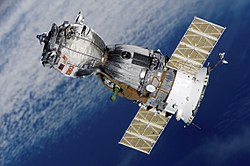| COSPAR ID | 1981-023A |
|---|---|
| SATCAT no. | 12334 |
| Mission duration | 74 days, 17 hours, 37 minutes, 23 seconds |
| Orbits completed | 1,178 |
| Spacecraft properties | |
| Spacecraft type | Soyuz-T |
| Manufacturer | NPO Energia |
| Launch mass | 6,850 kilograms (15,100 lb) |
| Crew | |
| Crew size | 2 |
| Members | Vladimir Kovalyonok Viktor Savinykh |
| Callsign | Photon |
| Start of mission | |
| Launch date | 12 March 1981, 19:00:11 UTC |
| Rocket | Soyuz-U |
| Launch site | Baikonur 1/5 |
| End of mission | |
| Landing date | 26 May 1981, 12:37:34 UTC |
| Landing site | 125 kilometres (78 mi) E Dzhezkazgan |
| Orbital parameters | |
| Reference system | Geocentric |
| Regime | Low Earth |
| Perigee altitude | 201 kilometres (125 mi) |
| Apogee altitude | 250 kilometres (160 mi) |
| Inclination | 51.6 degrees |
| Period | 88.7 minutes |
| Docking with Salyut 6 | |
| Docking date | 13 March 1981, 20:33 UTC [1] |
| Undocking date | 26 May 1981, 09:20 UTC [1] |
Soyuz programme (Crewed missions) | |
Soyuz T-4 was a Soviet space mission which launched the crew of Salyut 6 EO-6, the sixth and final long-duration crew of the Salyut 6 space station. It was launched on 12 March 1981 and docked with the station the next day. [1] During their stay, the EO-6 crew was visited by Soyuz 39 and Soyuz 40. Soyuz T-4 returned to Earth on 26 May 1981; its crew were the last to have inhabited Salyut 6. [2]
